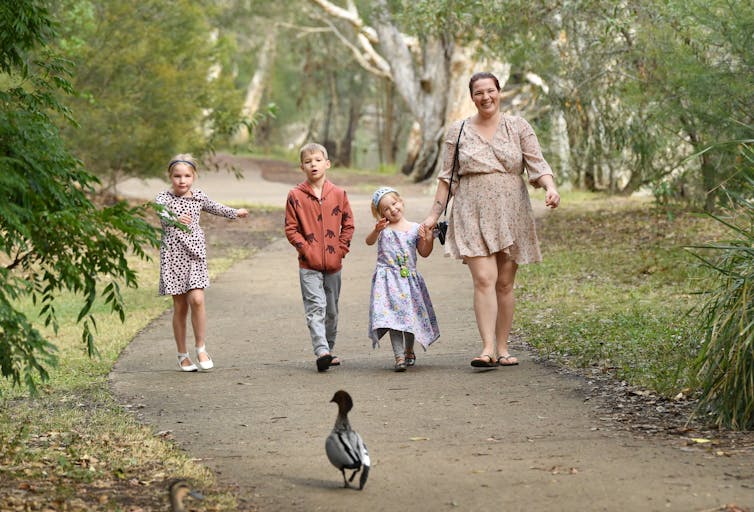Source: The Conversation (Au and NZ) – By Halvard Dalheim, Practitioner in Residence, The Henry Halloran Trust, University of Sydney
Living, working and playing in the one neighbourhood has often been touted as the ideal outcome for well-planned cities. Yet this goal has been elusive. For most of us, our daily activities are segregated into one-dimensional precincts.
Every morning we emerge from our “cave” and travel to a fixed place of employment. Thus, we are beholden to transport planners to manage our daily commute.
Read more: If more of us work from home after coronavirus we’ll need to rethink city planning
Then came COVID-19. Restrictions changed our behaviour – we adapted.
Those of us who could worked from home. We walked locally, shopped locally, exercised locally, “home-schooled” our children locally and bought take-away locally. For many, our neighbourhoods have become our new “world” where we live, work and play.We are now at a crossroad. One choice is to circle back to where we came as restrictions are eased. The other is to explore the opportunities our new behaviours have created.
We are in a position to explore the intersections between these new behaviours and how we think about our local neighbourhoods. Can we reach that elusive nirvana of work, rest and play locally?
Read more: Coronavirus reminds us how liveable neighbourhoods matter for our well-being
Re-imaging our neighbourhoods
Re-imagining our neighbourhoods is much more that enhancing the quality of the individual parts. We have an opportunity to strategically build on our behavioural adaptions to shift away from precincts based on simple one-dimensional land use. Just as many planners have been contemplating how autonomous vehicles might change our thinking about transport planning, re-imagining our neighbourhoods requires us to think well beyond our new behaviours.

Are there long-term implications of working from home? Will we change our perceptions of what activities we expect to see in our neighbourhood? What may influence our thoughts?
If we wish to move away from one-dimensional land-use precincts, we need to start at the home and consider where the boundaries between live, work and play lie. Some developers already provide homes with a tailored home office with a separate entrance. How could this evolve? Should we encourage it?
Such questions put into play planning regulations, but more importantly our expectations about the lifestyle of the place where we live. Many employment sectors are relatively benign in terms of nuisance impacts. Do we need to reconsider what activities are permissible as home-based businesses? And how many people can work at a home?
Read more: Life in lockdown has shown us our houses need to work harder for us
At the same time we can turn our attention to local centres and how they might evolve and grow. Interestingly, for Greater Sydney, the roughly 1,300 local centres account for close to 18% of all the city’s jobs, similar to that of the whole industrial sector. What placemaking and planning considerations require attention?
For both Sydney and Melbourne, the metropolitan plans identify councils as having those responsibilities. Should support come from state government? The role of governments is to be an enabler. For state governments there are tangible benefits to justify transferring and reprioritising resources to accelerate change.
Can we then look one step further and consider if there are opportunities to decentralise activities to the neighbourhood level? This might include post-secondary education and health services, community and social services. Can we turn community nodes into vibrant mixed-use local centres?
Making the shift from commuting
Walking our local streets has reintroduced many people to the human scale of their neighbourhood. The interactions at this scale are in stark contrast to the utilitarian role of many local streets. Their layout seeks to move cars in and out of our neighbourhoods as quickly as possible.
Our desire to “get out” and walk has also directed many people to their local centre. How can we support this new walking and shopping behaviour? The broad societal benefits range from healthier communities to reduced pressure on the transport network.

Do we now have an opportunity to take a long-term view? Can we use today’s disruptions to start re-imagining the structure of our neighbourhoods? This might be a journey of incremental steps such as:
-
developing a lattice of widened nature strips to restructure and re-orientate neighbourhoods to enhance local connectivity to where we work, rest and play and let us just safely walk our streets
-
creating “community corridors” by connecting existing local facilities and centres and strategically locating new activities
-
using the lattice together with the adaption of working from home as a catalyst to re-imagine the activities that can allow communities to live, work and play locally
-
enhancing local amenity and the human scale of neighbourhoods by expanding urban tree cover and pocket parks. Better street lighting might be an important enabler for a walking community, not just a minimum provision for those who may dare to walk.
Read more: Reclaiming the streets? We all can have a say in the ‘new normal’ after coronavirus
A new focus for planning
For probably the first time in planning’s history, all in the community are acutely aware of the challenges we face. And we all see the opportunity to work together on a pathway to recovery.
Re-imagining our local neighbourhoods might also suggest a new way of thinking about how we plan our cities. Our behaviour response to COVID-19 is shifting the metropolitan planning spotlight from the macro to the micro – the local neighbourhood – and to the importance of applying as much thinking and resources to that area as to the dynamics of whole metropolitan area.
A collaborative approach to a re-imagined neighbourhood will allow local communities to be actively involved in shaping their own and our collective future.
The fork in the road is clear. Which path we take is in our hands.
Read more: Coronavirus has changed our sense of place, so together we must re-imagine our cities
– ref. We’re at a fork in the road: do we choose neighbourhoods to live, work and play in? – https://theconversation.com/were-at-a-fork-in-the-road-do-we-choose-neighbourhoods-to-live-work-and-play-in-138949







